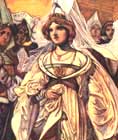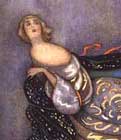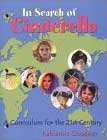
Cinderella:
345 Variants
by Marian
Roalfe Cox
SurLaLune's
Cinderella Area
SurLaLune Fairy Tales Main Page
279
Colshorn, Carl und Theodor, Märchen and Sagen. Hanover, 1854. No. XLIV, Pp. 143-47. (From Altenhagen.)
"ASCHENPOLING."
ABSTRACT
No one will be godmother to heroine, whose
parents have eleven sons and are poor. Old woman appears to father; stands
godmother; fetches child away in year-and-half, brings her up in house
in forest. When heroine is fifteen, old woman leaves her for three days.
Forbidden chamber entered; heroine drops thimble in cask of human blood;
cannot remove stain. She must leave old woman, who gives her wishing-box.
Hunting
Prince takes heroine to palace-- Menial heroine--Magic dresses--Meeting-place
(ball)--Threefold flight--Lovesick prince-- Heroine quest--Recognition
food.-- Happy marriage.
TABULATION
(1) A couple have eleven sons, and they have nothing to eat. Then the woman has a daughter who looks like a princess. Although the parents are delighted with the child, no one in the village is pleased, and no one will be sponsor.-- (2) One day father goes as usual to forest to hew wood, he rests under a bush and sighs from his heart. An old woman comes from behind bush and asks woodman what is the matter. At first he will not tell, but at last says that he has a lovely little daughter, and no one will stand godmother. Old woman shakes her head sadly, goes home with him, holds the child over the font, gives it three gold pieces, and vanishes.-- (3) When the child is one- and-a-half years old she comes back, and begs parents to let her take it away. She brings the girl up in her own house in the middle of the forest. Heroine is most beautiful, and on her fifteenth birthday old woman says she must leave her for three days. She gives her the keys, and she may go into all the rooms except the one which the little gold key opens.1 She must be careful to obey, or evil will befall them both. Heroine promises. First day she is too ad at parting wills old woman to open any of the rooms; next day she visits them all and is astonished at the splendour within. At night she has no rest fur thinking what must be in room which gold key opens. Next morning she looks at all the others again, and thinks that if she only opens door of for bidden room a little way and peeps, it can do no harm.-- (4) She looks in, and on the wall opposite door sees a great mirror with golden frame, and in the mirror a lovely girl in royal raiment, with a crown of gold on her head. She does not know it is herself. But as she goes nearer for better view she comes upon a cask full of human blood. She is frightened, and drops her thimble in, and, when she fetches it out, it is full of blood, and rub as she may, the blood will not go away. She has scarcely left the room when old woman returns, and seeing stained thimble, says, "Foolish child! when shall I ever be set free now!" and, weeping bitterly, old woman leads her from the house, and says, "Now are we parted for ever; I ought to be angry, but I cannot scold. Here is my baptismal gift. When you tap silently three times on this little box, and wish for anything,2 you will have it. God be with you! But I shall never set eyes on you more."-- (5) Old woman returns to house, and girl goes forth sobbing into the forest. She does not know her way, and the thorns tear her clothes, and hands and face; she has nothing but berries to ea and must sleep on the cold earth.-- (6) The king comes hunting in the forest; when heroine springs aside to escape the hounds, be thinks it must be some wild beast, and is about to slay it, when he sees in time that it is a girl. He has her taken to palace. Here she must carry wood and water, and stir the fire, and as she gets dusty and covered with ashes, she is always called Aschenpoling -- (7) King gives a ball that he may choose a bride; all the princesses are invited. At midnight, when heroine has put kitchen in order, she bethinks her that she would like a dance, and taps the little box, and wishes for a royal dress. Clad in this she enters ball-room; king is dancing with lovely princess, but leaves her, and dances till daybreak with heroine. Then she returns to her work, and king inquires in vain what has become of her.-- (8) Next night there is another ball, and again king forsakes princess to dance with heroine. Again she disappears, leaving him very s - (9) Third night he will dance with no one till heroine arrives. She is wearing a dress the like of which has never been seen. He gives her a gold ring, and thinks to himself that this time she cannot possibly escape him, for he has had the whole palace surrounded with soldiers. But she only has to return to kitchen, and do her dirty work.-- (10) King falls sick unto death, and sends messengers into all the world to seek the beautiful lady.-- (11) Three days afterwards the cook notices a ring on heroine's finger. When he questions her about it, she flings it into the soup-dish. King finds it, and asks cook whence came ring.-- (12) Cook tells all he knows, and king goes into kitchen and finds heroine wearing dress she wore at first ball ; he makes her his wife. When she is made quern and wears gold crown, she chances to look into large mirror, and knows who it was she saw in mirror before.
NOTES
Note 18
(P. 191.) For incident of "Forbidden Chamber", ci. Arnason, pp. 503, 534; Asbjornsen, i, 86; Busk, F.-L. R., "The Dark King," p. 100; Campbell, i, 265-275, No. 41; Cosquin, i, 133 ff.; Dasent, "The Lassie and her Godmother," p. 189, "The Widow's Son," p. 311 (3rd ed.) F.-L. Rec., iv, 152; F.-L. Journal, ii 193-242 (Hartland in "Forbidden Chamber"); ibid., v, 112-124 (Kirby on "Forbidden Doors of the Thousand and One Nights"); Germania, 1870, No. 6; Grimm, Nos. 3, 6, 46, and see i, 364, ii, 509; Gypsy-lore Journal, i, 26 (Roumanian tale); Hahn, ii, 197, and Nos. 15, 45, 68; Katha-sarit-sagara, iii, 223; Lang, La Mythologie, Paris, 1886; Minaef, Indiiskia Skaski y Legendy, No. 46; Pentamerone, No. 36; Prym and Socin, No. 58; Ralston, 98-100; Roumanian Fairy-Tales, p. 27; Schneller, No. 20; Stokes, No. 24; Tuscan Fairy Tales, No. 7 (tabulated in F.-L. J., ii, 186); Wide-Awake Stories, p. 14; Wolf, Deutsche Hausmärchen, No. 19. "Blue-Beard" and variants. Compare Psyche's curiosity in opening the pyx.
See No. 297 of this collection.
Return to place in text.
Note 19
(P. 192.) With the wishing-box in
Nos. 34, 224, and 279,
compare the wishing-pipe in Nos. 114 and
117, the wishing-dresses in Nos. 110
and 160; the ring in No.
190, the ball in No. 197, the sword
in No. 268, the wishing-eggs in No.
309, the wishing-bell in No. 324, the
magic whips in No. 326, the talismans
in No. 328, and the laurel, which grants
every wish, in No. 335. Similar talismans are found
in the following stories Am. F.-L. Journal, iii. 270; Busk, F.-L.
R., pp. 31, 146-54, 129, 131 (horn), 143 (wand), 152 (ring), 160 ff.
(lantern); Campbell, ii, 293, 303; Clouston, i, 314 ff.,"Aladdin's
Wonderful Lamp"; Cosquin, i, 121, "La Bourse, le Sifflet, et
la Chapeau," and variants; ii, 1-8, "L'Homme de Fer," and
variants (candle); ii, 80 (sabre); 284 (violin); 307, "La Baguette
Merveilleuse"; Dasent, "Three
Princesses of Whiteland" (ring), p 184; "Soria
Moria Castle," p. 402; Dozon, No. 11; Folk-lore Rec.,
iv, 142, Portuguese story (devil's ear); F.-L. Journal, ii, 240,
Mod. Gr. story, "The Enchanted Lake" (gold and silver rods);
ib., vii, 307 ff., Indo-Burmese story (ring); Gesta Rom.,
"Prince Jonathas"; Gonzenbach, Nos. 30, 31, 32; Grimm, No.
116, "The Blue Light"; No.
122, "Donkey Cabbages" (cloak); Groome, In Gypsy Tents,
p. 201, "Jack and his Golden Snuff-box"; Hahn, variant of No.
9; Kennedy, Fireside Stories, p. 67; Fictions of the Irish Celts,
p. 49; Mabinogion, p. 419 (wand); MacInnes, p. 347 (rod); Maspons,
Rondallayre, iii, p. 58; Pitré, Nos. 26, 28; Prohle, i, No. 27
(purse, trumpet, hat, and mantle); Ralston, p. 100; Sagas from Far
East, pp. 58, 133; Sebillot, Haute Bret., i, Nos. 5, 29; Sparks,
The Decisions of Princess Thoodhamma Tsari (Burmese Buddhist Aladdin);
Steere, Swahili Tales, p. 393, No. 13 (ring); Stokes, No. 23, "The
Princess who loved her Father like Salt" (sun-jewel box containing
seven little fairies), and No. 25; Symington, Sketches of Faroe and
Iceland, p. 225, "The Goblin's Whistle"; Theal, p. 77, and
see p. 45; Vernaleken, pp. 62, 80; Webster, 94-100, 597; Wide-Awake
Stories, 190 (box); Wolf p. 16; Zingerle, ii, 142. Compare the tarn-cap,
Wish's or Wuotan's hat, Pluto's or Orcus's helmet ([Greek name], Il.,
5, 845; Hesiod, Scut., 227); the fairy-purse of Fortunatus, and
other wishing-gear. For wishing -purse, -rod, -cloth, etc., see Grimm,
Teut. Myth., 871, 976, and see 142 ff. on the personification of
Wish. Volund's arm-ring brings wealth (see Rydberg, Teut. Myth.,
432). With the magic wand, which occurs in Nos. 1,
20, 21, 22,
27, 47, 55,
74, 89, 91,
96, 103, 106,
107, 108, (109),
120, 122, 124,
137, 146, 165,
184, 185, 208,
209, 230, 232,
233, 238, 250,
252, 253, 265,
269, 281, compare the caduceus
of Hermes; the rod of Moses; also rods used in divination (on which see
Grimm, T. M., 975, 1598). (Elisha's staff was believed, apparently,
to possess miraculous virtue, though it proved inoperative in the hands
of his servant. 2 Kings, iv, 29 sq.) There is a story of a wishing-staff
which St. Columban gave away to a poor man, and which he smashed at the
bidding of his wife (Adamanni Scoti, Vita S. Columbae, cap. 24).
The gods have a golden staff with which they touch and transform: [Greek
name] (Od., 16. 172, 456; 13. 429). Circe strikes with her staff (Od.,
10. 238). Skirni threatens with a magic wand ("Lay of Skirni,"
C. P. B., i, 111). Shiva has a miraculous bow, so has Indra, according
to the Vedas. Apollo's bow carries plague: cf. Odin's spear, Gungnir,
the hurling of which brings victory; and Thor's hammer, Miölner,
which comes crashing down as a thunderbolt, and of itself returns to the
hand. Freyr had a sword of similar nature that swung itself. Such gear
the Greeks call [Greek name] (Il., 18. 376). Mr. Grant Allen considers
the notion of Thor's hammer to be derived from the shape of the supposed
thunderbolt. "Thor's hammer is itself merely the picture which our
northern ancestors formed to themselves, by compounding the idea of thunder
and lightning with the idea of the polished stone hatchets they dug up
among the fields and meadows." These were preserved from motives
of superstition, since the possession of a thunderbolt gives one some
sort of hold over the thunder-god himself. "This is the secret, too,
of all the rings, lamps, gems and boxes, possession of which gives a man
power over fairies, spirits, gnomes, and genii. All magic proceeds upon
the prime belief that you must possess some thing belonging to the person
you wish to control, constrain, or injure" (Essay on "Thunderbolts",
by Grant Allen: Falling in Love, and other Essays, pp. 137-158).
Return to place in text.
Cox, Marian Roalfe. Cinderella: Three Hundred and Forty-five Variants of Cinderella, Catskin, and Cap O' Rushes, abstracted and tabulated. London: David Nutt for the Folklore Society, 1893.
While the original text of this book is out of copyright, the special formatting and compilation available on SurLaLune Fairy Tales is copyrighted. Be aware that while the original content has been honored, page numbering, footnote numbering, redesigned charts, links, and other aspects are unique to this site's version of the text. Use at your own risk. For private and fair use educational purposes only.
©Heidi
Anne Heiner, SurLaLune Fairy Tales
E-mail: surlalune@aol.com
Page last updated February 1, 2006
www.surlalunefairytales.com










